
| Preface | Perth | Stuart Highway | Uluru | Port Douglas | Sydney | Sturt Highway | Kangaroo Island | Indian Pacific | Perth |
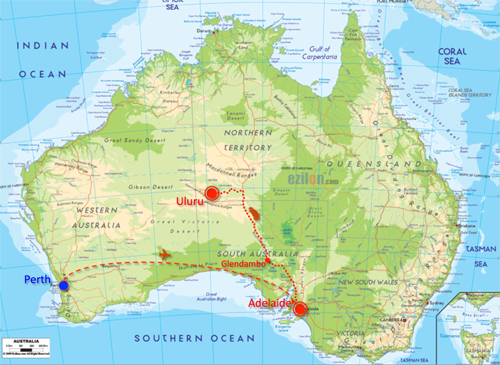

Before we could get started on the two day outback drive to Uluru, first we had a pre-dawn flight from Perth to Adelaide, and then of course we had to go shopping. Internal flights in Australia are remarkably stress free. Minimal security, no long walks to gates, no long lines at the gate, and most shocking of all, the gate is a door that opens directly onto the tarmac. That's me in the red jacket and my remaining hat coming down the back stairs at Adelaide, and Claudia was standing in the terminal doorway when she turned to grab this shot. After the 50 yard walk from the terminal to the car rental to pick up the car, we drove into the center of Adelaide (complete madness) to replace the first of my hats and to get provisions for the trip. Nervous about the dietary options in one-horse towns and gas stations, Claudia was determined that we would have sufficient backup on-board that it didn't matter what else was on offer. This was a delicate balance, first because if she's eating, I eat too, but more importantly this put a severe damper on my ability to graze serendipitously. After a long discussion we were able to come to an excellent compromise, and instead of begrudging "the waste of time, money, and my reckless calorie-loading" Claudia actually began to look forward to the morning bakery stops on the hunt for long blacks and meat pies, to name just one example.
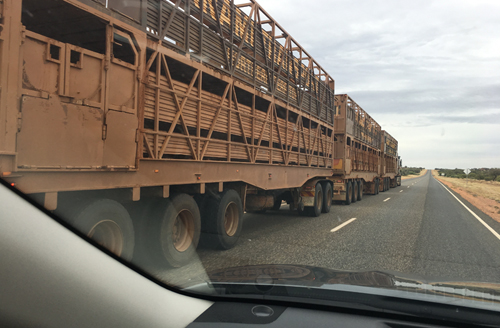
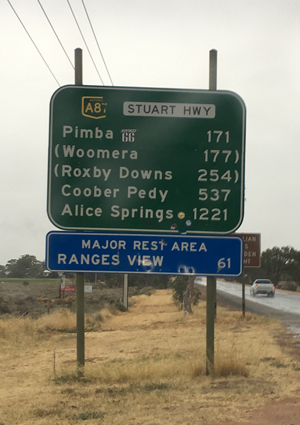
Finally by noon or so, sporting my spiffy new Tilly hat (and inevitably with Claudia sporting a sexy new Aussie Outback hat) a bag full of provisions, two gallons of water, and wearing the crumbs from my first meat pie, we were on the road north. Slowly. The traffic was heavy, it was raining and the roadworks went on for miles. We had to cover 590km on the first day, (365 miles) to get to Glendambo. Coober Pedy was nearly 300 km further, and if we didn't get to one or the other of these on the first night, we didn't stand a prayer of getting to Uluru the next day.
The problem was not so much the travel time— Glendambo is only 6:30 (traffic free) hours from Adelaide, it was the issue of not being willing to drive after dark. If my memories from the last trip were not enough, the rental car assistant's warnings, and the "not covered for damage caused by collisions with wildlife" clause in the contract sealed the deal. So wherever we were going, we needed to get there by 6:30pm give or take.
The rain came and went, and eventually so did the traffic. We were pretty much half way there by the time we felt we could officially pull off the road to record that we were in the outback on the Stuart Highway, often referred to simply as "The Track". Stuart Highway runs from Darwin, Northern Territory, via Alice Springs, to Port Augusta, South Australia, 2,834 km (1,761 mi). Wikipedia describes it as "the principal north-south route through the central interior of mainland Australia" but I would go further: it's the only route through the central interior unless you were thinking dirt tracks and four-wheel drives and two spare tires. The highway is named after Scottish explorer John McDouall Stuart, who was the first European to cross Australia from south to north, and indeed the highway approximates the route Stuart took. Travelling as far as Alice Springs, we were going to do about half of it, (plus the 263km (163 miles) each way diversion to Uluru).
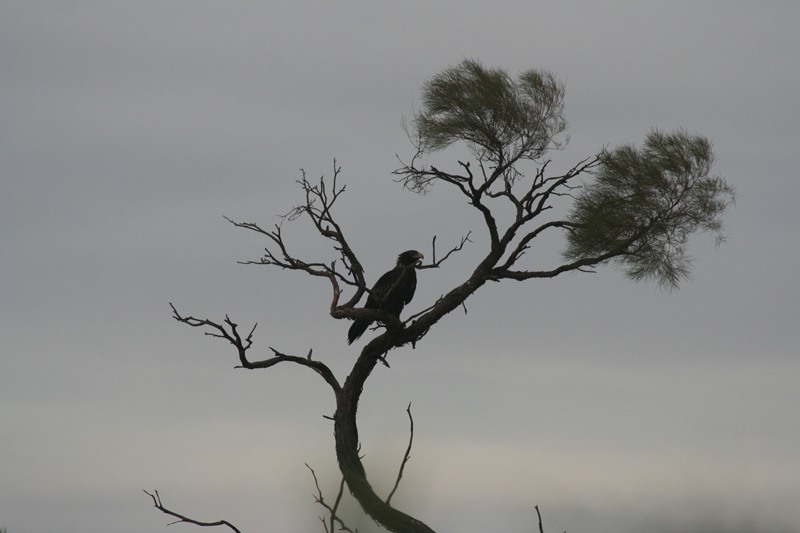
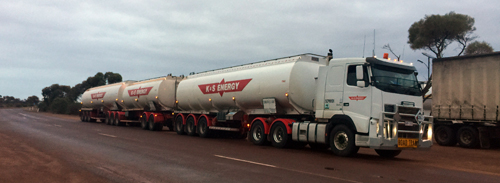
It's obvious enough why the steering wheel and pedals need to be on the other side of the car for countries where they drive on the left. What is considerably less obvious is why they would feel the need to also switch sides of the steering column for the windshield wipers and the indicators. Other drivers were forced to predict my changes in direction by observing the wipe speed of the wipers, or to wonder why I felt the need to turn left every time it started to rain. Claudia made a note in my log book that I only noticed later: "Richard turned on the windshield wipers 83 times when he meant to use the turn signal."
The miles rolled by, the hours rolled by, with occasional bursts of excitement. A flock of vibrant green, yellow-bellied parakeet/budgerigars. A wedgetailed eagle, an old truck with a single faded warning painted down its sides: Caution: Explosives. Tearing passed a road train, or the stress of a large and obviously fairly recent road kill. Within minutes of Claudia wondering out loud if we were ever going to see any marsupials, a pair of kangaroos bounced over the fence paralleling one side of the road. We stopped and watched them for several minutes, but they were too far away to photograph.

Glendambo
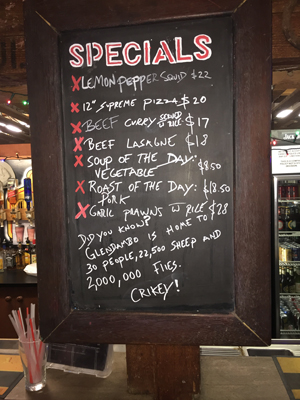
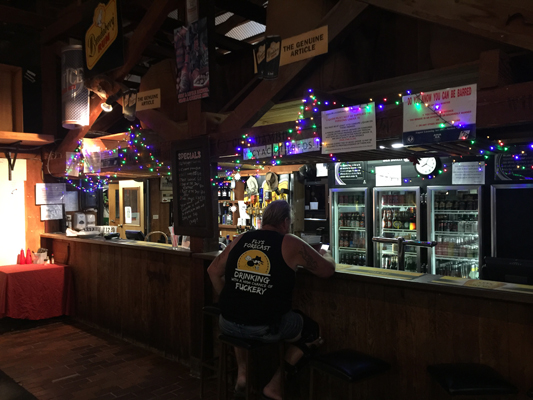
Right at dusk we rolled into Glendambo. To our delight, it was a classic one-horse town with a roadhouse and that's about it. As the sign says: the population is 30 people, 22,000 sheep, and 2,000,000 flies. As usual, the roadhouse comprised a tavern, a motel, and a gas station. We drove around the buildings and found the motel behind the tavern). But we couldn't find the office, so I went in to the bar to ask. "Rite oh" the barkeep said, "through that door". I walked through the door into a dark room with chairs on table tops looking like it hasn't been used in months. The barkeep merely moved down the bar which ran right through into this room. But there was a separate till here, and more importantly, it took credit cards.
Key in hand we drove back around behind the tavern into the gloomy courtyard. As usual there was just enough light to navigate by but no more, to grope your way back and forth between one's room and the bar. Several patrons sat outside their rooms smoking and drinking beer out of the bottle, each in their own pool of light like an Edward Hopper painting.
Our room was huge giving us the luxury of spreading our stuff out, but was otherwise classic motel spartan. Claudia was even more excited by the wifi which was excellent (go figure) and so she was only too happy to shove me out of the door again for my pilgrimage to the bar.
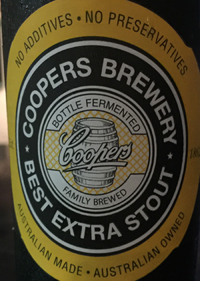
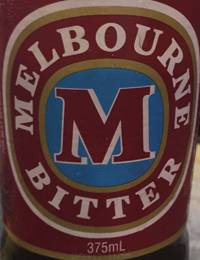
The tavern which could easily accommodate 200 people was accommodating fewer than a dozen, one of whom is the bar maid sitting with her friends. The gas station obviously is out front and a little to one side, and behind it, next to the tavern is a small shop like you'd see at gas stations throughout the planet. But it is also the breakfast cafe. It was a mystery why breakfast could not be served in the tavern, but there we are.
I asked the barkeep if he had any of the new microbrews. It was almost as if he didn't know what I was talking about. "Such as?" Of course I couldn't name any, but that's not the point: the ones I could not name would be even more interesting than the ones I could. "Oh I don't know, the new-fangled hoppy IPAs for example." "Oh no" he says suddenly catching on "we just have the beers people like to drink."
I had a Melbourne Bitter followed by Coopers Best Extra Stout, the two darkest beers he had. Average and drinkable-but-unexceptional respectively. I wandered around the bar since there was nothing to keep me sitting at it (the barman disappeared), and there was nothing begging to be ordered on the menu. The most interesting thing in the bar was this guy. Something about his demeanor suggested he was not much of a conversationalist, but perhaps it was just his t-shirt or the way he so amply filled it. I'm perhaps too liberal with the f-bomb, but I've always felt that there is a huge divide between saying something and wearing it for the world to read and re-read. This delightful example reads: "Fly's Forecast: Drinking with a High Chance of Fuckery" which gets 1 star for the use of an apostrophe, but otherwise left me pondering. Am I missing something, or is it just a straight forward joke that he thought hilarious enough to spend money on so he could become a walking billboard for others to enjoy? Is it about flies or about his own aspirations?
Glendambo to Uluru
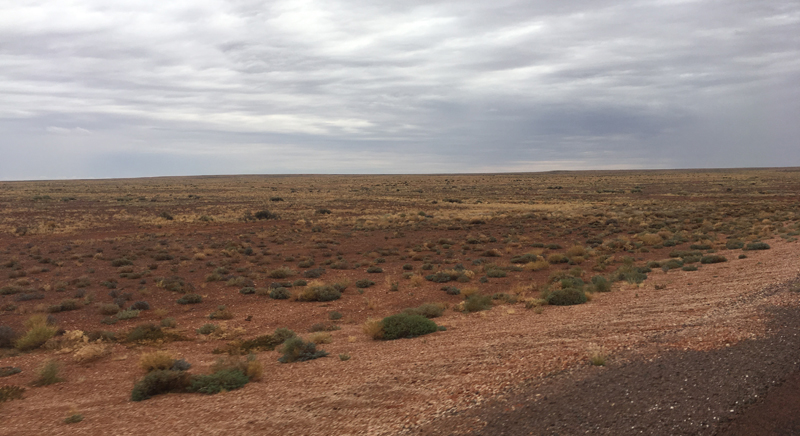
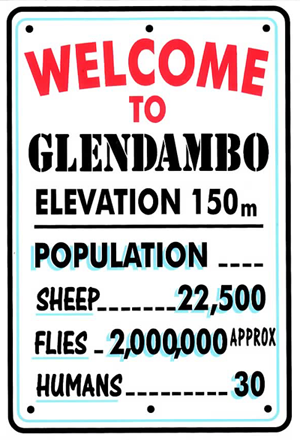
1,000km (620 miles) today. There's nothing much to report, but I guess that's sorta the point. There were two places we knew we wanted to stop if we had time, and Coober Pedy was one of them. One of the most famous opal mining towns in all of Australia, it's probably the largest town on the road except Alice Springs. That still did not make it a very big place, and it felt like we drove from one end to the other and back again in well under 5 minutes. It was an untidy mixture of run down stores interspersed with the occasional clearly high end hotel, one even boasting a conference centre. Several claimed to be underground, which I don't doubt, since using disused mines as houses and other accommodation is a well-known and obvious trick for avoiding the heat—and the cold—since once you are a couple of yards down the temperature stabilizes at a very comfortable 70ish Farenheit, 22ish Centigrade. Given more time I'd've have happily given it another shot, but CMT was more sceptical, having seen the pictures I took last time. It was hard for me to imagine these upscale places having the same white-washed but otherwise just-the-way-the-miners-left-it rough hewn walls, but if it looked just like a regular hotel corridor, then where was the fun?
Claudia is not into opals, so there was no point in shopping, (a first) and we didn't have time to do the one thing that might have proved that the town was more than a tourist trap living on its former glory: a trip down an actual mine, which here in Coober Pedy was apparently big enough to drive those monster dump trucks in and out of. Next time. That left one thing to do: hunt down a meat pie. We found a cafe with locals hanging about outside (not much doubt about the distinction between locals and tourists in a mining town) and had to wait almost as long for the coffee as we did for Claudia's gluten free thing to heat up and a plate of fries to get fried. All excellent.
We gassed up, because you always gas up, and headed on our way again. Again the hours rolled by easily with our book-on-tape. We stopped rolling a few times too, in a vain attempt to capture the landscape, or once or twice, something in it, but like yesterday they were far too distant. Still it was something of a relief to at least be able to say we'd seen emu, kangaroos, and wallabies, though if this is the best we can do for sightings it would be pretty disappointing overall.
A great blog we had read on the Adelaide to Alice road trip recommended an indigenous art center as a (or perhaps I should say the only) worthwhile diversion on the Coober Pedy leg. Part galley, part salesroom, it sounded right up our street. Except the street was closed, and along with it, the art gallery. Thank goodness we read and recognised the one small sign announcing the closure before making the 30 mile detour. That and a number of other disappointments, most especially Alice itself are why the blog is not linked here.
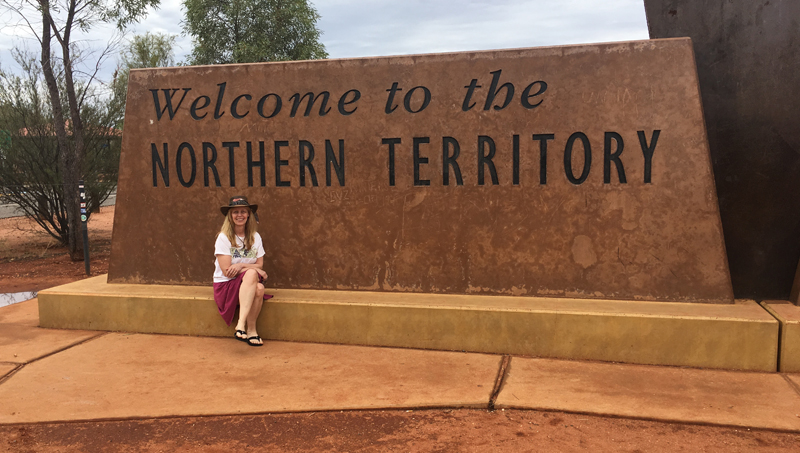
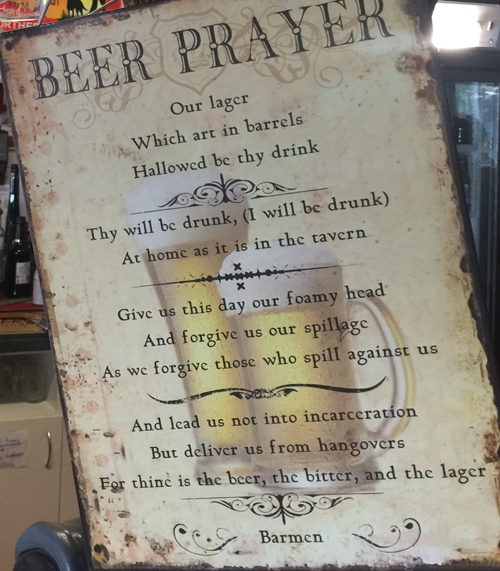 Kulgery Hotel. First and last pub in Northern Territory.
Kulgery Hotel. First and last pub in Northern Territory.
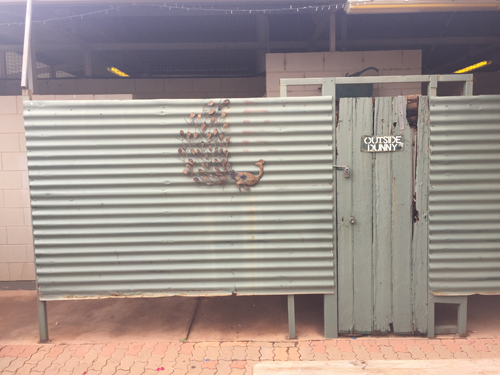
So the first major milestone after Coober Pedy was the Northern Territory border, and there was no mistaking that, and no closing it either. The relentless sun and heat had beaten so much of the color out of the tourist information boards that they were almost unreadable. Either that or the trampling underfoot by the flies has worn the print away. All-in-all a been-there-done-that moment, take a snapshot and quickly head back to the cool and insect-free car.
Why we decided to pull into The Kulgery Hotel is now a mystery even CMT could no longer unravel. We didn't need gas, we didn't need to eat, and we did have a race against the dark. We could have just needed a break, but I think more likely they must have had a sign advertizing indigenous art and it might therefore in some small way make up for the closed art center. What is not in dispute was that they had a whole room stacked with paintings from postcard size to poster and we spent five or ten minutes flipping through the pieces and picking out a couple for purchase. The bar was also nice and eclectic. No way I didn't sample something, but again details are lost. But we were there, these snaps including the incongruously elegant dunny, and the art now hanging at home prove it.
It was not long after the most important milestone of the day, turning off the highway for Uluru, when a monolithic mountain appeared on the horizon to our left. Uluru! Or was it? It seemed so soon. This detour was supposed to be more than 150 miles, and yet only 15 miles down the road we could already see the objective? How many flat-topped slabs could there be out here? But something was not right. We photographed it anyway, just in case, and moved on. Once we reconnected to the interweb, we were able to confirm that this was Mt Connor. I wondered how many others drove by here asking the same questions.
A little too late we pulled in to the resort. The last 45 minutes were too dark, Claudia white-knuckling the dashboard hoping to get an early warning of incoming meat and even then we had a couple of close calls. Nothing dangerous, but enough to reinforce the don't-drive-after-dark rule.
Uluru - Ayer's Rock Resort
The Desert Gardens Hotel was an elegant oasis 500 miles from anywhere. It was surrounded by a small village of lesser establishments, camp grounds, shops, and restaurants, but I definitely had the feeling that this was the epicenter. The front entrance was often two deep in buses large and small, and the long reception desk with uniformed staff stationed at regular intervals along it had all the hallmarks of a swanky downtown hotel.
Since this was one of the places Claudia had booked our room was of course lovely. We even had an Uluru view (the real one this time) though since it was already dark, and it would still be dark when we left for our tour in the morning, this perk was of limited advantage. Claudia was beat, so while she had a bath and prepared for bed, I set off in search of light refreshment.
The whole village was purpose-built, and nicely planned to be people/pedestrian friendly. Paths ran between the several hotels and across to the "town square" which was a small plaza lined with gift shops and snack bars. It wasn't merely mood lighting: it was decidely moody. The 50watt bulbs were so far apart that some more experienced guests were sporting their own flashlights. The three lamps closest to us were out altogether, leaving the last 50 feet in complete darkness. But we groped our way through the little garden that formed the courtyard of the hotel until we found the block containing our room. A porter had hustled the bags around the outside in a golf cart and was there to meet us. A lovely room with an all-glass wall looking out into the darkness, but which would reveal Uluru when we were finally here in daylight.
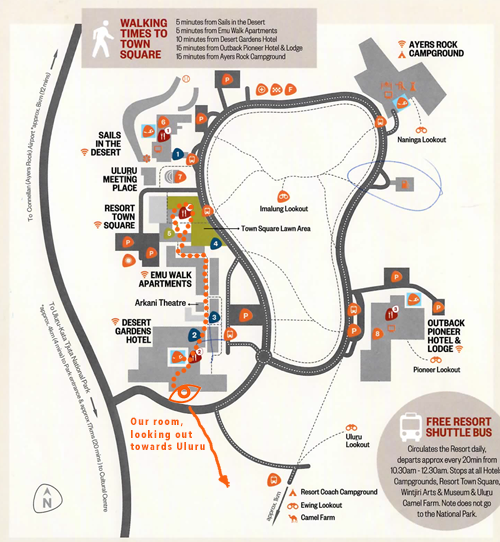 Village Map, with our room with a view marked, and a dotted line tracing my wander to the village center.
Village Map, with our room with a view marked, and a dotted line tracing my wander to the village center. With Claudia settled in and looking forward to her bath, I set off out again, right through the hotel garden and then pressed on behind a large art gallery and motel to the square. It was packed, despite the fact that most of the stores were closed already. The cheapest place (a burger/pizza/sandwich joint) had fluorescent lighting and screaming kids (pass), the most interesting (fusion Asian) had no seats and no alcohol (sigh), and the remaining places weren't even interesting enough to remember. I guess I wasn't really very hungry, it was about the experience rather than the sustenance, and nothing got close to checking the "experience" box.
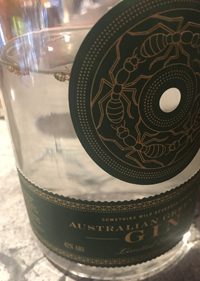
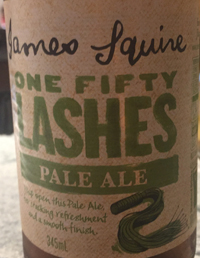
Back to our bar, a nicely civilized and considerably quieter destination that formed one edge of the aforementioned garden. There were half a dozen other snobs dotted about the bar and small tables on the terrace: in short, a typical upmarket hotel bar. There were two things that made it noteworthy. First was that they actually had some interesting beer, and were making a concious attempt to support the new microbreweries, so I had my first James Squire 150 Lashes IPA. Much more spectacularly I noticed a gin that I did not recognise, and which the menu implied was called "Green Ant Gin". I asked the barista about the strange name. "Because it has green ants in it?" she explained. "Seriously?" She got the bottle down and showed me the ants floating in it. "Crikey!" "It's all part of the new craze to use indigenous ingredients." "Crikey! Could I get a shot of it?" "A straight shot? That's a bit unusual." "Maybe, but that's the only way to make sure that what I'm tasting is the ant gin, and not all the other stuff you put in the cocktail." She carefully measured the shot into a glass, and just as carefully spooned an escapee ant back into the bottle. "Don't do that on my account!" I cried, too late. "I wasn't. I'm required to keep them in the bottle." Makes sense I suppose, saving them for more curious guests like me. We will return to the subject of green ant flavor, which to my great delight turned out to be something of a running theme over the next week or so, but suffice to say that the gin definitely had a distinctive, and delicious, citrus flavor. Delightfully, I later discovered she had not charged me for it either. With our pre-dawn start in the morning it was already time for me to call it a night.